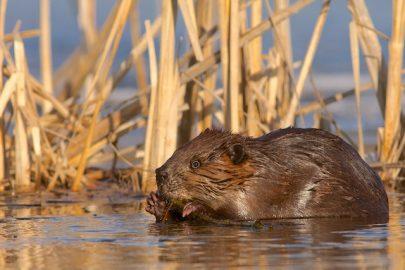by Kathleen Keefe
As you walk along the waterways in High Park, you might wonder why some trees are wearing wire cages around their trunks. This armour effectively discourages beavers from chewing on the trees. You will notice that it’s too late for a few trees.

If you’re tempted to think, “Oh, those dam beavers!” let’s look at it from a beaver’s point of view. Beavers have to chew wood to survive. They eat wood for food and to keep their ever-growing front teeth from getting too long. They also fell trees to build dams and lodges. As the largest rodent in North America, beavers, Castor canadensis, are actually grounds keepers extraordinaire.
The dams beavers build increase wetlands, reduce erosion and attract more wildlife. When a tree falls into Grenadier Pond (whether at the hands and teeth of a beaver or because the shallow roots of a non-native tree can’t hold on to the sandy shore) lots of good things happen. Fish habitat is enlarged and improved.
The increased sunlight encourages more aquatic plants, wildflowers and shore grasses. This removes sediment and pollutants from the water and attracts more insects, amphibians, reptiles and mammals. And BINGO! Our beaver is a habitat hero!
You’ve probably heard how busy beavers are. However, it’s unlikely you’ll get to witness their industrious feats because they are shy and they work at night. Beavers are impressively adapted to their aquatic responsibilities. In the water, its large leathery tail is both propeller and rudder. On shore, a beaver's tail gives support in both sitting and standing positions. To sound an alarm to fellow beavers, they slap their tails on the water. Their large webbed hind feet become powerful paddles for swimming. A clear membrane covers their eyes so they can see underwater, and before entering the water, special valves in their ears and nostrils close. The back of a beaver’s mouth is built to prevent water from entering its lungs when it is carrying a mouthful of building supplies underwater. These features enable beavers to stay underwater for 15 minutes at a time!
Beavers use their small dexterous front paws to arrange mud, stones and sticks for building dams and lodges. Perhaps their fur is the most important characteristic. It is extremely thick with long coarse outer hairs and fine short inner hairs that help the beaver survive in freezing water. After swimming underwater for quite some time, a beaver’s skin remains dry.
Before Europeans arrived in Canada, it’s estimated there were six million beavers in Canada. By the mid 1800s, nearly all of them had been killed for their fur. We are lucky to have them back right here in High Park.

























